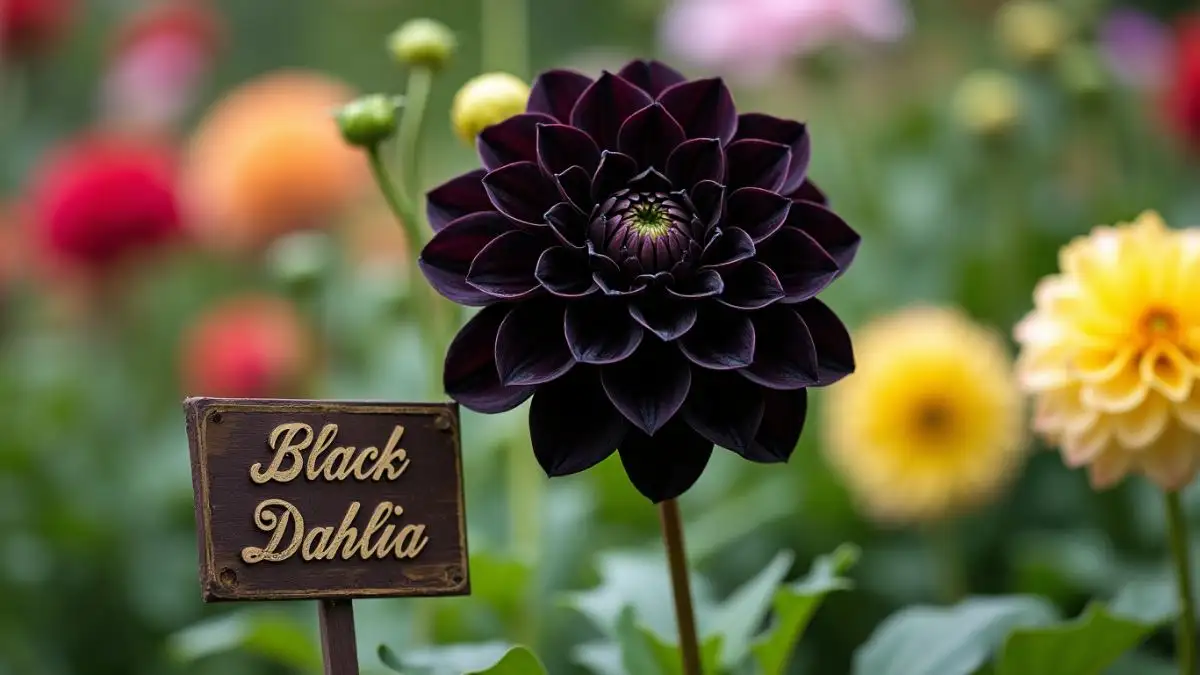Introduction
The Black Dahlia plant is more than just a flower—it’s an emblem of mystery and elegance. With its dramatic, dark-hued blooms, this plant stands out in any garden, captivating everyone with its velvety petals and intriguing history. Whether you’re new to gardening or a seasoned enthusiast, understanding the unique aspects of Black Dahlias flower can elevate your gardening game. This guide uncovers seven amazing facts about the Black Dahlia plant, along with expert tips for growing, caring for, and incorporating these flowers into your space. Let’s delve into the enchanting world of the Black Dahlia.
Table of Contents
The Origins of the Black Dahlia Plant
Historical Background
When you admire the Dahlia Black plant, you’re gazing at centuries of horticultural artistry. Native to Mexico and Central America, dahlias have long been treasured for their beauty and versatility. The Black Dahlia, in particular, is not a naturally occurring variety but a hybrid bred for its deep, almost black tones. The name “Black Dahlia” became especially popular due to its association with mystery and sophistication.
Fun Fact: Did you know that dahlias were originally cultivated for their edible tubers? The Aztecs valued them as a food source, though today we’ve shifted our appreciation to their ornamental appeal.
Cultural Significance
The Black Dahlia carries profound symbolism. Its dark, velvety petals often represent inner strength, elegance, and dignity. You might also find it in gothic-themed gardens or floral arrangements, where it adds a touch of drama and allure. Its name has also been immortalized in pop culture, linked to an infamous unsolved mystery, which adds to its enigmatic reputation.
Unique Characteristics of the Black Dahlia Plant
Stunning Appearance
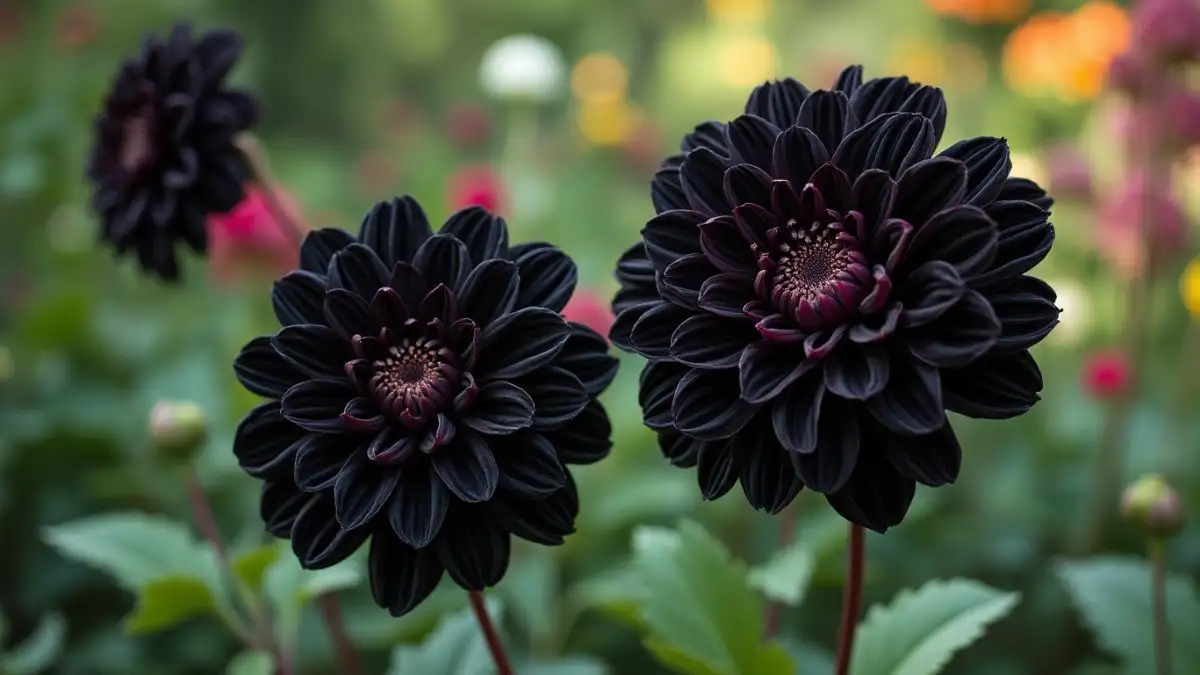
Imagine a flower so dark it seems to hold the essence of night. The Black Dahlia’s blooms range from deep maroon to near-black, depending on the lighting. Varieties like the Black Satin Dahlia and Verrone’s Obsidian Dahlia showcase velvety textures that demand attention.
These flowers aren’t just about color. The decorative and semi-cactus forms offer unique petal shapes that create depth and intrigue in your garden.
Growth Habit
The Black Dahlia plant grows up to 4 feet tall, making it a commanding presence. It thrives in full sun and well-drained soil, ensuring robust blooms that last through the growing season. Its upright habit also makes it ideal for the middle or back rows of garden beds.
How to Grow and Care for Black Dahlia Plants
Planting Tips
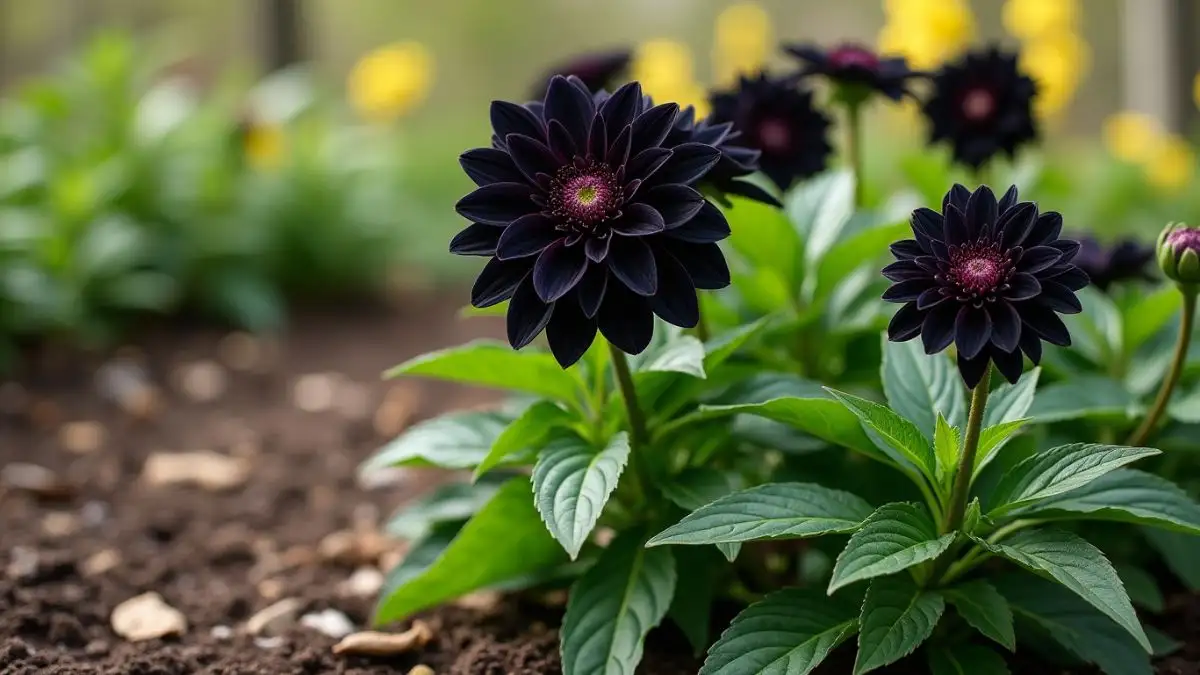
- Planting Time: Start planting your Black Dahlia tubers in early spring once the risk of frost has passed.
- Soil Requirements: Ensure the soil is rich and well-draining, with a pH between 6.0 and 7.0. You can amend your soil with compost for added nutrients.
- Spacing: Space tubers 12-18 inches apart to allow good airflow and prevent diseases.
Care Guide
- Watering: Black Dahlias need consistent watering, but be cautious to avoid soggy soil. Drip irrigation systems work wonderfully to keep the soil moist without overwatering.
- Fertilizing: Feed your plants every 4-6 weeks with a balanced fertilizer. Avoid excessive nitrogen, as it promotes foliage at the expense of blooms.
- Deadheading: Frequently remove faded flowers to promote new blooms and keep the plant looking neat.
- Winter Storage: In colder climates, you’ll need to dig up the tubers after the first frost. Keep them in a cool, dry location until spring.
Common Pests and Diseases
Black Dahlias are relatively resilient, but they can occasionally fall victim to pests and diseases. Here are some strategies to safeguard your plants:
- Aphids and Spider Mites: These small pests can damage foliage. Apply insecticidal soap or neem oil to control pests effectively.
- Powdery Mildew: This fungal disease can be prevented with proper spacing and good airflow around your plants.
- Slugs and Snails: Protect your Black Dahlia plants by using organic barriers or slug traps.
Popular Black Dahlia Varieties
Top Cultivars
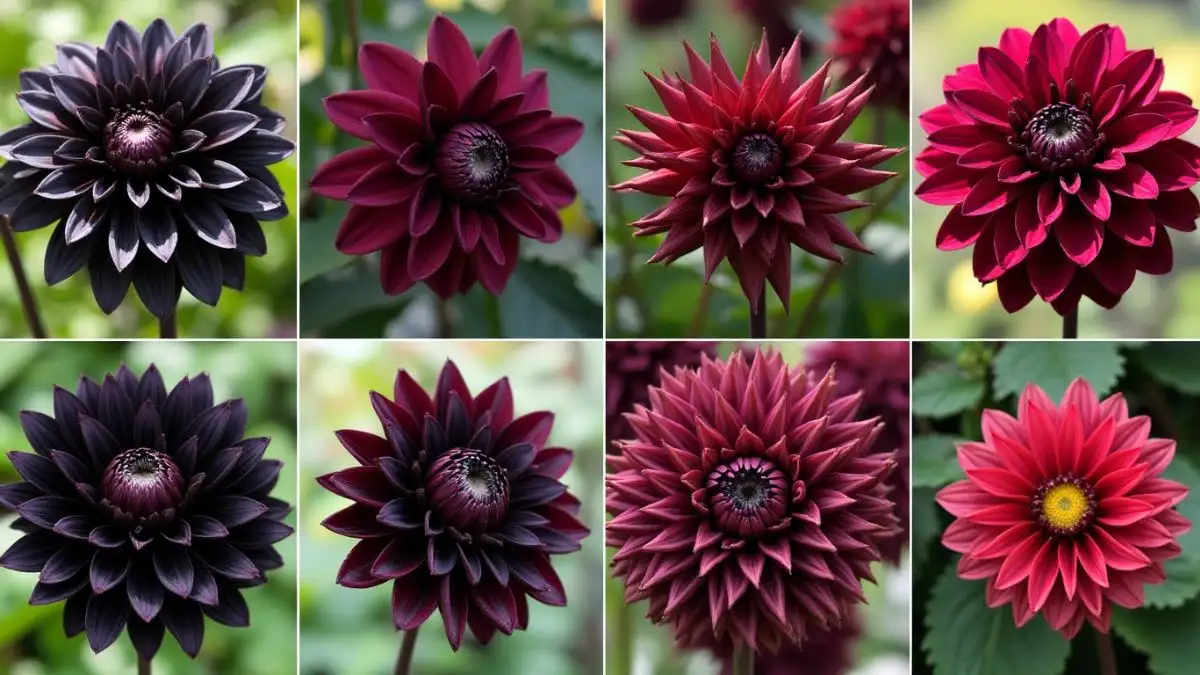
You have several stunning options when selecting Black Dahlia varieties for your garden. Here are some favorites:
- Black Satin Dahlia: Known for its glossy, dark petals that shimmer in sunlight.
- Black Narcissus Dahlia: A semi-cactus variety with spiky, dramatic blooms.
- Verrone’s Obsidian Dahlia: A velvety, deep maroon flower that makes a bold statement.
- Arabian Night Dahlia: This variety features rich, dark red petals with hints of black.
- Black Touch Dahlia: Its fringed petals add an extra layer of texture to your garden.
Comparison Table
| Variety Name | Bloom Type | Height | Special Features |
| Black Satin Dahlia | Decorative | 3-4 ft | Glossy, dark petals |
| Black Narcissus Dahlia | Semi-Cactus | 3 ft | Pointed petal edges |
| Verrone’s Obsidian | Decorative | 4 ft | Dramatic appearance |
| Arabian Night Dahlia | Decorative | 3.5 ft | Deep red-black color |
| Black Touch Dahlia | Fringed | 3 ft | Unique petal shapes |
Black Dahlia in Floral Arrangements
Tips for Stunning Bouquets
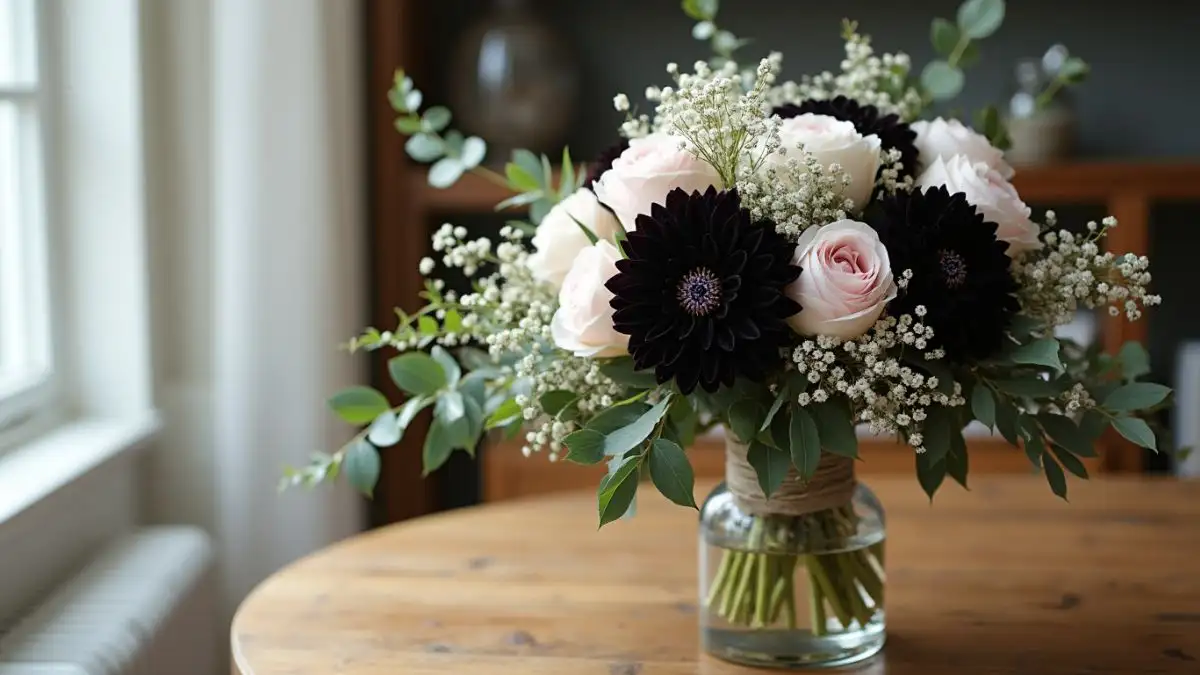
The Black Dahlia is a florist’s dream, offering endless possibilities for striking arrangements. Here are some tips:
- Pair Black Dahlias with lighter blooms, like white roses or pink peonies, to create stunning contrasts.
- Use eucalyptus or ferns as greenery for a natural yet dramatic touch.
- Incorporate seasonal flowers for a fresh, cohesive design.
DIY Arrangement Recipe
| Ingredient | Quantity |
| Black Dahlia Blooms | 5-7 stems |
| White Roses | 3-5 stems |
| Eucalyptus Foliage | 4-6 sprigs |
| Baby’s Breath | 2-3 clusters |
| Ribbon or Twine | 1 piece |
Black Dahlia in Landscape Design
Creating a Dramatic Garden Theme
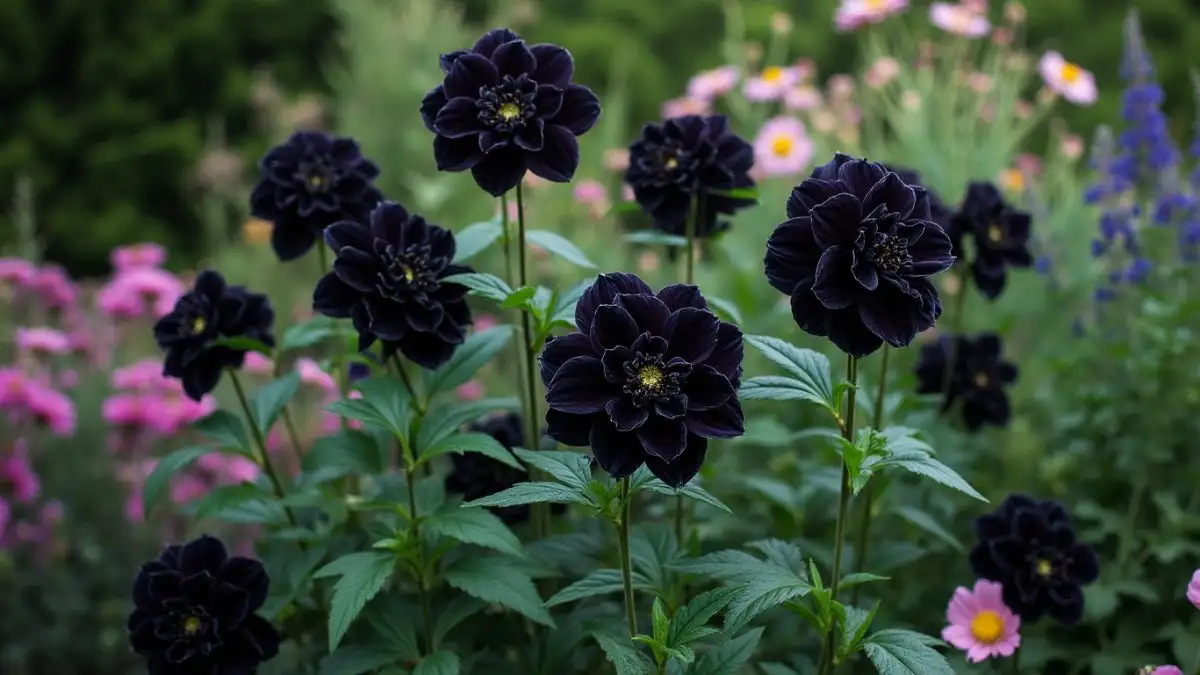
Black Dahlias make an impactful addition to themed gardens. Consider these ideas:
- Gothic Gardens: Combine Black Dahlias with dark foliage plants like Black Mondo Grass and Heuchera.
- Night Gardens: Pair them with white and silver plants for a stunning nighttime display.
- Romantic Gardens: Surround Black Dahlias with soft pinks and purples for a luxurious look.
Companion Plants
Black Dahlias thrive alongside plants that share similar light and soil requirements. Great companions include:
- Salvia
- Lavender
- Ornamental Grasses
- Coneflowers
The Black Dahlia in Art and Culture
Symbolism in Art
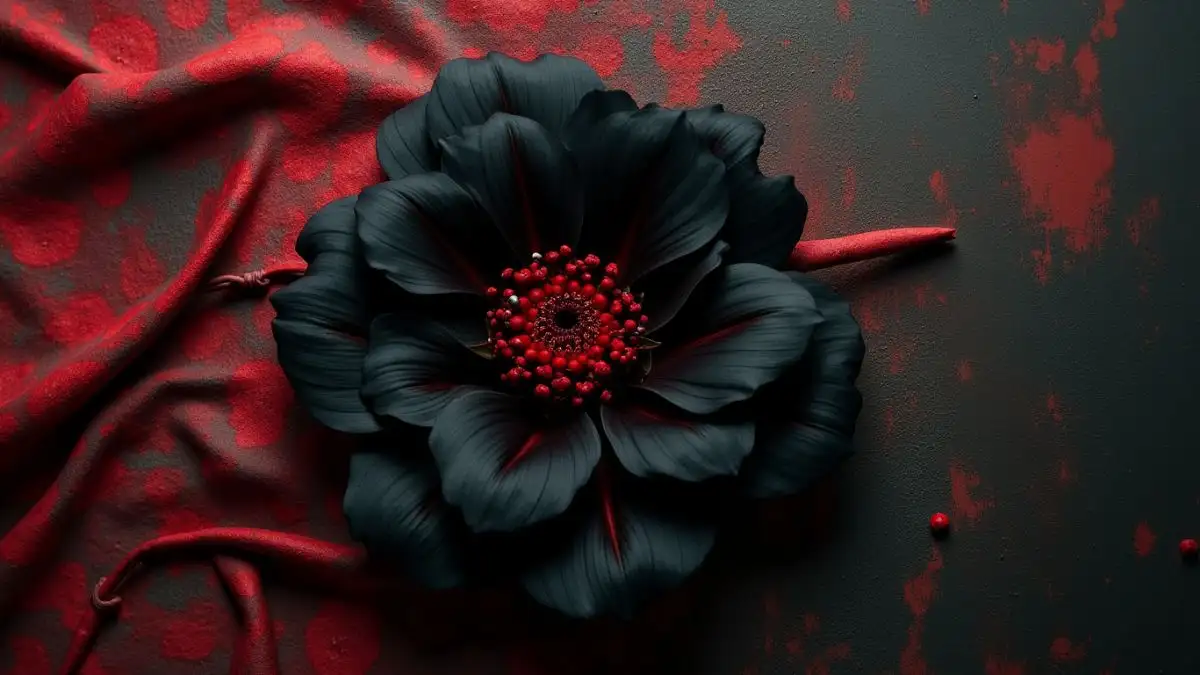
The Black Dahlia has inspired artists and designers for generations. Its deep, mysterious hues symbolize elegance, mystery, and individuality. Whether depicted in paintings, fabrics, or sculptures, the Black Dahlia continues to captivate creative minds.
Pop Culture References
The “Black Dahlia” name is famously associated with a 1947 unsolved murder case, which has been the subject of numerous books, films, and TV shows. This connection adds an air of intrigue and mystique to the flower, making it a favorite for gothic and noir-themed projects.
Interesting Facts About the Black Dahlia
Fascinating Trivia
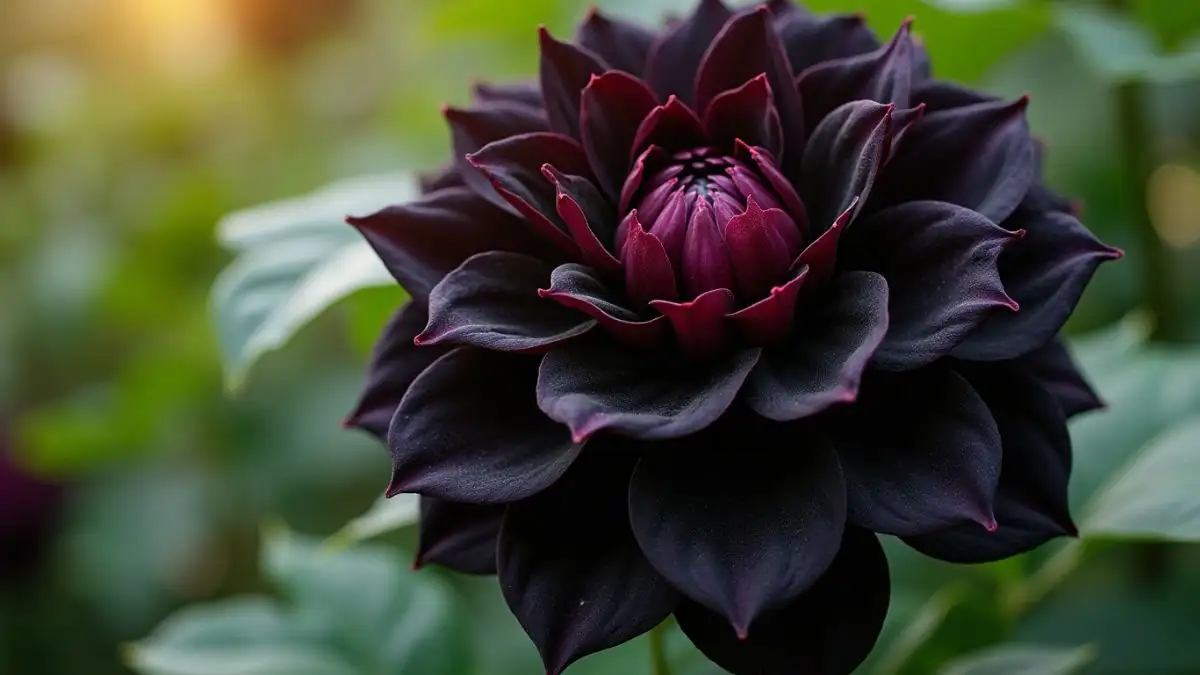
- The Black Dahlia’s color appears darker in cooler temperatures, making it a favorite for fall gardens.
- Despite their dramatic appearance, these flowers are relatively low-maintenance when their basic needs are met.
- The Black Dahlia is often used as a symbol of creativity and individuality, making it a popular choice for personal gardens.
- They are frequently featured in gothic and avant-garde floral designs.
- The Black Satin Dahlia’s shimmering petals are especially captivating under sunlight.
Common Questions About Black Dahlia Plants
FAQ Section
- Is the Black Dahlia plant difficult to grow? Not at all! With proper sunlight, soil, and care, you can grow these stunning flowers with ease.
- Why is it called the Black Dahlia? Its name comes from its dark hue and its association with the famous “Black Dahlia” mystery.
- Can Black Dahlia plants grow indoors? While they thrive outdoors, you can grow them indoors with ample sunlight and space.
- Are Black Dahlias toxic to pets? Yes, they are mildly toxic to cats and dogs if ingested, so keep them out of reach of curious pets.
- How do you propagate Black Dahlias? Propagate them by dividing tubers or using stem cuttings for new growth.
- What’s the best climate for Black Dahlias? They thrive in temperate climates with full sun and moderate humidity.
- Do Black Dahlias attract pollinators? Yes, they are fantastic for attracting bees, butterflies, and other helpful pollinators.
- How long do Black Dahlia blooms last? Their blooms can last for several weeks with the right care.
- Can Black Dahlias survive frost? No, they are not frost-tolerant. In colder climates, dig up the tubers and store them indoors.
- Are Black Dahlias edible? While their tubers were historically eaten, the flowers themselves are not typically consumed.
Conclusion
The Black Dahlia plant is a unique and captivating addition to any garden. Its deep, velvety petals and intriguing history make it a standout choice for gardeners who appreciate beauty with a touch of mystery. By following the tips outlined here, you can grow and care for these flowers successfully, creating a stunning display that will leave everyone in awe. Whether you’re using them in bouquets or as garden centerpieces, Black Dahlias are sure to impress. Start your journey with these enchanting flowers today and bring a touch of drama and elegance to your space.


